APAC: Leveraging AI at Scale to Drive Value
The Asia Pacific (APAC) region is witnessing a shift from experimental AI projects to strategic deployments aimed at maximizing business impact.
This strategic pivot is driven by the understanding that AI's true value lies in its ability to enhance customer experience, automate back-office processes, and streamline sales and customer lifecycle management, as outlined in the "APAC AI Outlook 2025" report, a joint initiative by Ecosystm and IBM.
Balancing Short-Term Gains with Long-Term Vision
Across APAC, organizations are redefining how they leverage artificial intelligence (AI), focusing on strategic projects that promise substantial business value. This shift marks a departure from short-term wins and emphasizes a more balanced approach that aligns with both immediate operational needs and long-term innovation goals.
The report indicates that nearly 60% of these organizations anticipate that the benefits of their AI investments will materialize within two to five years, and only 11% anticipate immediate returns.
This indicates a growing understanding that the transformative power of AI lies in its potential to create lasting impact. The key areas identified for leveraging AI include enhancing customer experience, automating back-office operations, and streamlining sales and customer lifecycle management. However, realizing these benefits requires significant investment and careful planning.
To bridge the gap between short-term objectives and long-term aspirations, organizations are employing a dual strategy. This involves securing early wins that build internal momentum and support, while simultaneously pursuing initiatives that align with broader business goals such as innovation, scalability, and financial sustainability. Achieving this balance entails a rigorous evaluation of AI projects, not only based on their financial return but also on their potential to transform job roles, improve data governance, and seamlessly integrate with existing digital infrastructure.

Autonomous AI Agents: Enhancing Workflow Automation
The emergence of autonomous AI agents marks a significant leap forward in operational efficiency. Powered by generative AI (GenAI), these agents are equipped to understand complex directives, make real-time decisions, and adapt to ever-changing business environments.
Unlike traditional automation tools, autonomous AI agents operate independently yet maintain the ability to collaborate effectively with human workers. This dual functionality addresses the dynamic needs of businesses, ensuring that operations remain efficient while delivering superior customer experiences, more personalized and responsive interactions.
Integrated AI Management: Ensuring Compliance and Cohesion
As AI ecosystems grow more complex, organizations are recognizing the urgent need for robust governance and integration frameworks. Multi-modal and multivendor environments present unique challenges, especially as regulatory landscapes evolve, with legislation like the EU AI Act setting new benchmarks for compliance.
To address these challenges, organizations are adopting integrated AI management practices that prioritize cohesion and compliance. Key components of this approach include:
- AI Model Management: Tools and platforms that streamline AI workflows, ensuring smooth integration across systems.
- Development Frameworks: Standardized frameworks that automate development tasks, enhance reliability, and accelerate deployment.
- Vendor Management: With solutions from a wide array of vendors, organizations will look for unified frameworks to ensure consistency, security, and compliance across solutions.
- Automated AI Lifecycle Oversight: Real-time monitoring systems to detect issues and ensure operational integrity.
By investing in these governance tools, organizations can future-proof their AI ecosystems, ensuring they remain agile, secure, and compliant.
Streamlining AI: The Shift to Customized, Resource-Efficient Models
The AI landscape is witnessing a shift towards smaller, purpose-built models. These specialized AI systems offer a viable alternative to large language models (LLMs), delivering comparable performance with reduced computational demands. This trend aligns with organizational goals to innovate using proprietary data while minimizing costs.
Smaller, open-source models are gaining traction due to their ability to address specific needs, such as local language processing and region-specific applications. Their resource efficiency not only reduces operational expenses but also supports sustainability initiatives by consuming less energy.
This move towards tailored, lightweight AI solutions is expected to drive innovation while enhancing both performance and explainability. Furthermore, the ability to deploy these models on smaller devices broadens their applicability, making them an ideal choice for diverse use cases.
Human-Focused AI: Innovating for Better Experiences
The evolution of AI is no longer just about improving productivity—it is about enriching human experiences. This shift places the user at the center of AI development, driving the creation of solutions that are not only functional but also emotionally intelligent and ethically sound.
To achieve this, organizations are prioritizing the following principles in AI innovation:
- User-Centric AI Development: Designing AI systems that understand and respond to human emotions and needs.
- Individualized AI Engagement: Tailoring interactions to individual preferences, ensuring a more engaging and personalized user experience.
- Clear and Transparent AI: Enhancing trust through clear, understandable explanations of AI-driven decisions.
- Ethical AI Practices: Aligning AI operations with human values to ensure fairness and inclusivity.
- Iterative Improvement: Using user feedback and performance metrics to continually refine AI systems for optimal functionality and user satisfaction.
This human-centered approach underscores the importance of trust, transparency, and adaptability in AI adoption, ensuring that technological advancements align with societal values and expectations.
A Balanced Path Forward
As organizations in the APAC region advance their AI strategies, the emphasis on balancing short-term achievements with long-term vision is crucial. By adopting a dual approach that integrates operational efficiency with innovation-driven goals, businesses can harness AI's transformative potential.
By harnessing autonomous AI agents, implementing cohesive governance frameworks, adopting resource-efficient models, and prioritizing human-centered solutions, organizations can unlock AI's full potential to revolutionize industries, deliver unparalleled customer experiences, and foster long-term, sustainable growth.
Related Insights.











